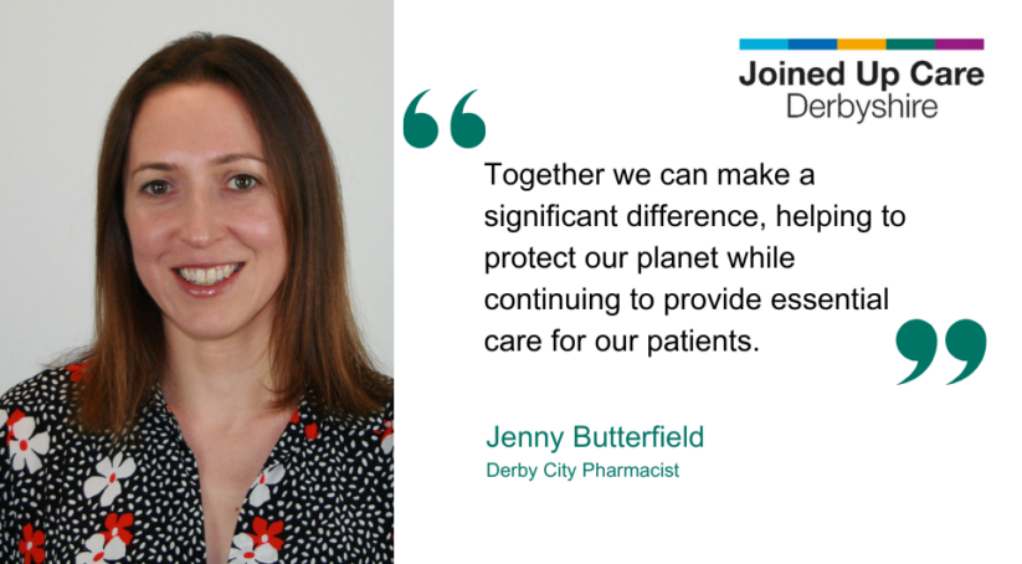Three things you can do to help the NHS in Derby and Derbyshire reduce its carbon emissions
In this blog, Jenny Butterfield, a Pharmacist in Derby and Derbyshire, talks about the effects of inhalers on the environment, and what we can do to reduce the NHS’s carbon footprint.
The NHS has a target to achieve a ‘net zero NHS’ by 2040 but we need your help. Net zero means that the amount of carbon emissions we add to the environment is no more than the amount taken away.
Currently, around 3% of the entire NHS carbon emissions result from pressurised metered dose inhalers which is the most commonly used inhaler and the one you will most likely think of when you hear the word ‘inhaler’.
This might seem like a small number, but inhalers account for more carbon emissions than any of our NHS buildings, energy use, waste, water or travel, so it is clearly an area where we can make a big difference!
Inhalers are essential for millions of people with respiratory conditions like asthma and chronic obstructive pulmonary disease (COPD). While these devices are vital for health, pressurised inhalers use ‘hydrofluoroalkane’ (HFA), which is a powerful greenhouse gas and is released into the atmosphere when inhalers are disposed of.
Did you know that one pressurised inhaler produces the same greenhouse gas effect as driving 175 miles. That’s Derby to Southampton by car!
How can we help the NHS reduce its carbon footprint? The main thing we can do is to look at prescribing different types of inhalers that have lower carbon emissions. Two examples of these are called ‘dry powder inhalers’ and ‘soft mist inhalers’. Dry powder inhalers use inhalation to administer the medication, without the need for any propellants. Soft mist inhalers use a spring mechanism instead.
One dry powder inhaler (a greener alternative) is only 4 miles by car. That’s Derby to another part of Derby!
These types of inhalers won’t work for everyone, and that’s ok, many people may still need to use a pressurised inhaler so their asthma is well managed. The doctor or nurse will be able to advise on this. We don’t want anyone switching to a different inhaler if it isn’t appropriate, but we encourage patients to have the conversation. Speak to your healthcare professional about switching to a greener alternative.
Find out about the different types of inhalers here.
We can also reduce our carbon emissions by supporting people to manage their asthma better, so they don’t need to use as many inhalers. In three months from June – August 2021, over 100,000 pressurised inhalers were prescribed. If we can support people to manage their asthma better, this would reduce the number of inhalers needed and reduce our carbon footprint, as well as improving the care of our patients.
If inhalers aren’t disposed of correctly, this can lead to the release of harmful gases into the environment. You should return your used inhalers back to your pharmacy rather than throwing them in the bin. Most pharmacies can dispose of inhalers correctly to stop the gasses being released.
There are a few ways in which you can help us on our mission.
If you have asthma, ask about switching to a greener inhaler at your next respiratory review. Greener inhalers won’t work for everyone, and that’s ok, your healthcare professional will guide you on this.
If you are using your reliever inhaler more than three times per week or you are waking up with nighttime symptoms, this might mean that your asthma is not being managed well. Speak to your asthma nurse for advice.
Finally, don’t throw your used inhalers in the bin! Return them to your local community pharmacy.
Achieving Net Zero by 2040 is an ambitious goal, but taking small steps like this will help make it a reality. Together we can make a significant difference, helping to protect our planet while continuing to provide essential care for our patients.

